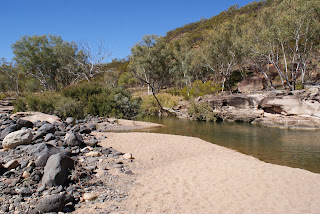The 27 km long gorge stretches 120 metres into the earth and
200 million years worth of geological history is revealed. Some time ago, the
earth here was pushed upwards and between six and two million years ago it was
covered by sheets of basalt and lava that had erupted from a series of small
volcanoes- perhaps from Mount Desolation (an extinct volcano) nearby. The basalt formed a hard cap over the elevated land surface.
Porcupine Creek (a tributary of Queensland’s longest river-
the Flinders) then eroded through the basalt and finding softer rock underneath,
proceeding to cut down to its current level. The hard basalt on the edges preventing them from eroding, and a gorge was created. In the “gutter” you can
still see the sandstone eroding now. There are different layers on sandstone evident
in the walls of the gorge today and many huge holes where smaller rocks have
circulated during the wet season to form circular gouges. Porcupine Creek is a
permanent water source for many native flora and fauna, including echidna,
geckos and wallaroos and galahs.
It was a rocky path in, steep in parts and a bit challenging for young legs but so worth it.
First up is the view from the lookout...
The smooth sandstone floor, rising red, brown and white cliffs and clear river was fascinating and simply stunning. We did think we saw some tiny fish but couldn't be certain.
Okay- some of the water was not fresh, nor flowing, but the algae was flourishing!
Amazing rock formations, smooth and yet pocked with holes (some quite deep) often with stones and sometimes sticks and chunks of wood inside.
On the steep ascent we learnt the value of storytelling and two of Aesop's fables and an epic version of Hansel and Gretel were made to last the entire climb, and not one complaint was heard from Amelia.
Woo-hoo!






















No comments:
Post a Comment